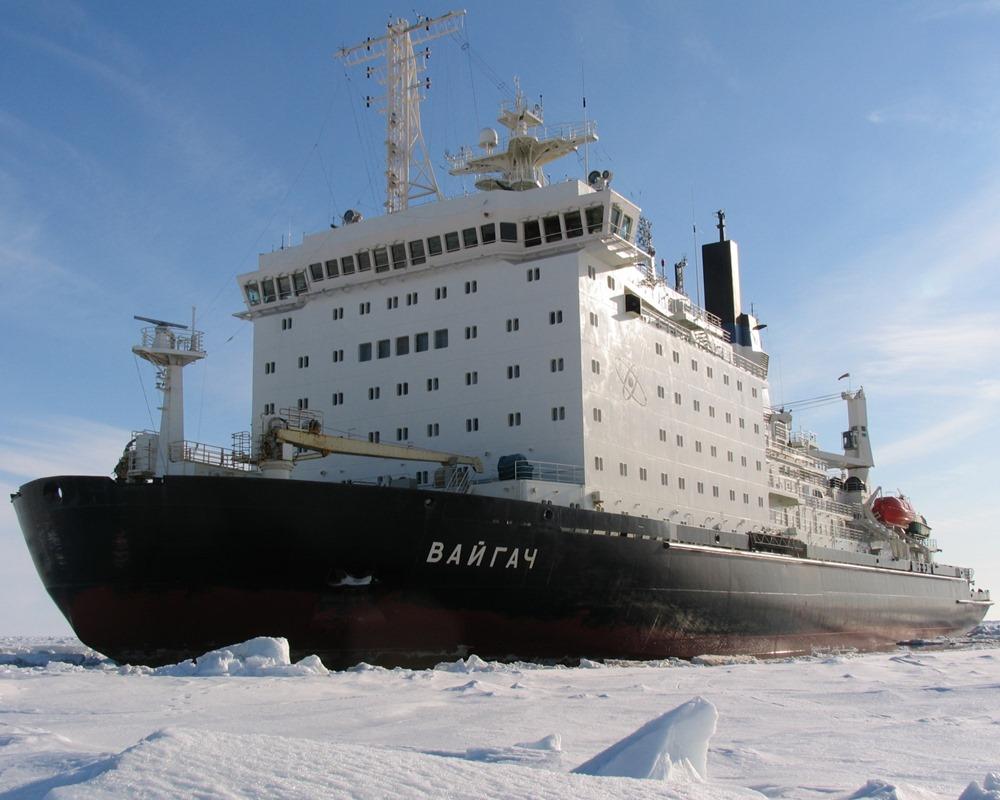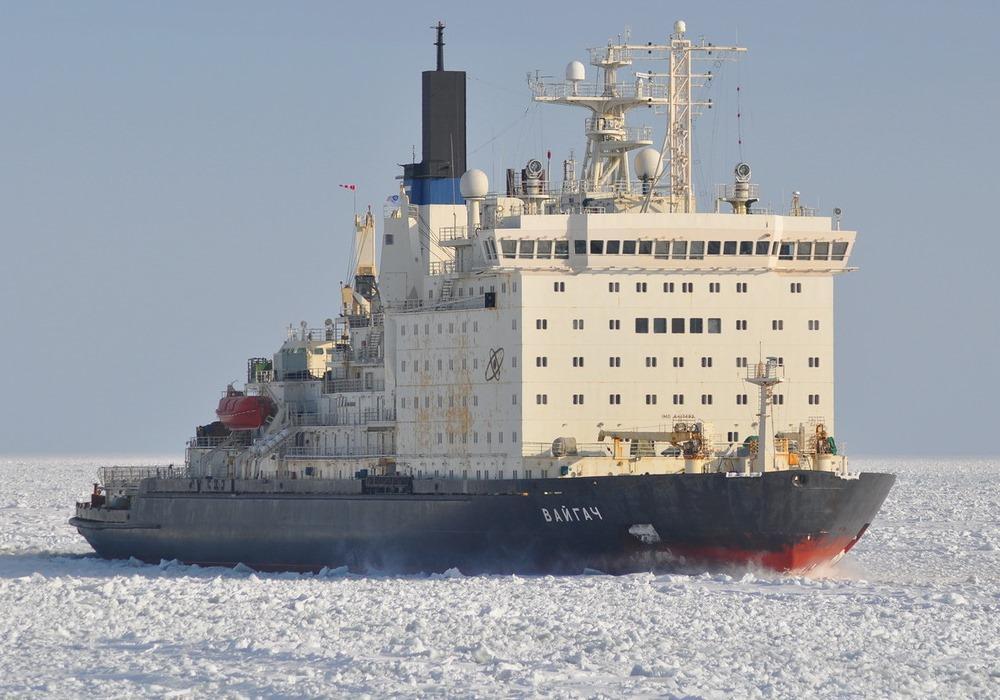Vaygach icebreaker
Vaygach icebreaker current position
The current location of Vaygach icebreaker is in North Russia (coordinates 71.41766 N / 83.19725 E) cruising at speed of 10.1 kn (19 km/h | 12 mph) en route to IB ASSIST CH17. The AIS position was last reported 38 minutes ago.
Current PositionSpecifications of Vaygach icebreaker
| Year of build | 1990 / Age: 35 |
| Flag state | Russia |
| Builder | Wartsila Hietalahti shipyard (Helsinki, Finland), Baltiysky Zavod/Baltic Shipyard (St Petersburg, Russia) |
| Class | Russian nuclear icebreaker (Taymyr-class) |
| Ferry route / homeports | Murmansk |
| Engines (power) | KLT-40M nuclear reactor + GTA 6421-OM5 steam turbines (207.8 MW / 278664 hp) |
| Propulsion power | 74.8 MW / 100308 hp |
| Speed | 20 kn / 37 km/h / 23 mph |
| Length (LOA) | 150 m / 492 ft |
| Beam (width) | 29 m / 95 ft |
| Gross Tonnage | 20791 gt |
| Passengers | 189 |
| Crew | 138 |
| Decks | 10 |
| Decks with cabins | 7 |
| Last Refurbishment | 2015 |
| Sister-ships | Taymyr |
| Owner | Russian Federation (via FSUE Atomflot) |
| Operator | Rosatom (Rosmorport) |
Vaygach icebreaker Review
Review of Vaygach icebreaker
The 1990-built NS Vaygach ("атомный ледокол Вайгач") is a Russian nuclear icebreaker. "NS" stands for "nuclear ship". The vessel is state-owned (by the Russian Federation via FSUE Atomflot) and operated by Rosatom. The Atomflot company provides all Russian nuclear icebreakers with maintenance and technological services. The company also serves the country's special vessels fleet.
The vessel (IMO number 8417493, Helsinki Shipyard/hull number 475) is currently Russia-flagged (MMSI 273133100) and homeported in Murmansk.
One of Russia's icebreaker ships, Vaygach is a nuclear-powered, shallow-draft icebreaking vessel. It is the second of 2 similar-design ships - launched after the sistership Taymyr. Vaygach was built for the USSR (Soviet Union) according to an order by the Murmansk Shipping Company. Vaygach has an ice-breaker traditional hull. The design features sloping sides and a highly-raked stem to reduce ice loads and improve maneuverability.
Besides NS Vaygach, the list of other active Russian nuclear icebreaker ships includes Rossiya (2027/Project Leader), NS Arktika (2020), Sibir (2021), Ural (2022), Yakutia (2024), Chukotka (2026), Taymyr (1989, sistership), Yamal (1992), 50 Let Pobedy (2007), Sevmorput (1988/cargo ship).

The cold-resistant steel used for the vessel's hull was delivered by the Soviet Union. Initially designed for a crew of 100, the ship's large superstructure contains accommodation for 138 personnel. In addition to other social premises, there is an auditorium that doubles as a recreational (lounge) room and winter garden used to provide fresh vegetables during the long polar night. Vaygach has a helideck and hangar for Kamov Ka-32 helicopter and is equipped with a stern notch and standard towing winch for close towing in hard conditions.
Vaygach is classified with the Russian ice-class LL2 by the Russian Maritime Register of Shipping. It means the vessel is intended for icebreaking operations on Arctic routes in packed ice conditions (up to 2 m / 7 ft thick ice during the months of winter and spring). The vessel's shallow draft additionally allows operations in rivers and other locations where the water is not deep enough for the big Arktika-class icebreakers and the ice conditions are severe, so refueling of diesel-powered icebreakers is close to impossible.
The Vaygach icebreaker's itinerary program offers North Pole expedition cruises and also longer itineraries on the Northern Sea Route along Russia's Arctic coastline.
Russia's nuclear fleet of ice-breaking vessels is used exclusively in the Arctic Ocean for escorting merchant ships and assisting research stations floating in the ice-covered waters north of Siberia. These ships are also used for scientific and Arctic cruise expeditions. The Russian nuclear ice-breakers must sail in ice-cold waters to effectively cool their reactors.
NS Vaygach vessel details
The Taymyr-class vessels were designed with a considerable effort put into improving their safety. These nuclear-powered ships were designed to operate in areas with only 80 cm / 2,6 ft of water beneath the keel. All critical systems are duplicated in order to improve reliability. This design also allows the icebreaker ship to maintain operational capability even after a collision with a 25000-ton freighter (SA-15 class) at speed of 7 knots (8 mph / 13 kph).

Vaygach and her sistership Taymyr are among the last icebreakers with the WABS (Wartsila Air Bubbling System) marine technology implemented. The WABS releases pressurized air from nozzles (below the waterline) thus lubricating the hull and reducing friction between ice and steel.
Both nuclear ships were constructed at Wartsila Hietalahti shipyard (Helsinki, Finland) - hulls, superstructure, and propulsion. However, their nuclear reactors (powerplants) were installed at Baltiysky Zavod (Baltic Shipyard) in St Petersburg, Russia).
The vessel has 1 dining room, Sauna, Library, Auditorium, Passenger Lounge, Volleyball Court, Gymnasium, 1 swimming pool (indoor, heated), Infirmary, 1 elevator, 1 helipad (helicopter deck) with a KA-32 transport helicopter.
- DWT Deadweight tonnage: 3550 tons
- Displacement tonnage: 21100 tons
- Clear path width: 50 m (164 ft)
- Max Draft: 9 m (30 ft)
- Icebreaking capacity: 2 m (7 ft)
- Range: unlimited
- Powerplant: KLT-40M nuclear reactor (171 MW output); 2 x GTA 6421-OM5 steam turbines (18,4 MW output each, or 36,8 MW combined power output)
- Propulsion: Nuclear-turbo-electric; 3 shafts (12 MW output each, or 36 MW combined power output); three 4-bladed fixed pitch propellers (combined power output 38,8 MW).
Note: In the case of poor AIS coverage, tracking the vessel's current location will be impossible. You can see CruiseMapper's list of all icebreakers and ice-breaking research ships in the "itinerary" section of our Icebreakers hub. All states and their fleets are listed there.
Other Rosatom-Rosmorport Russia cruise ships
Vaygach icebreaker Wiki
In 2017, Rosatomflot completed scheduled drydock works to extend the service life of the sister-ships Vaygach and Taymyr. The service life of the icebreakers' propulsion and nuclear reactors was extended to 200,000 hours, which enabled the vessels to serve for 5 more years (until 2022). Each of the ships operates with a single-reactor propulsion unit (rated power ~50,000 hp / 3,7 MW). The extended service life of the reactors allowed Atomflot to operate them without interruption, gradually introducing the "Project 22220" nuclear icebreakers (Arktika, Sibir, Ural) without breaking its contractual obligations.

